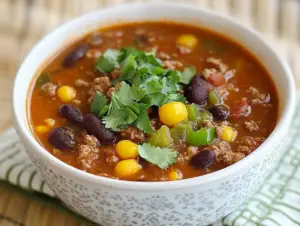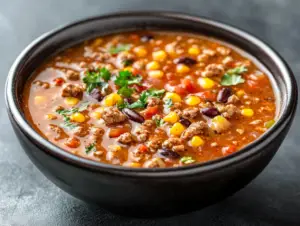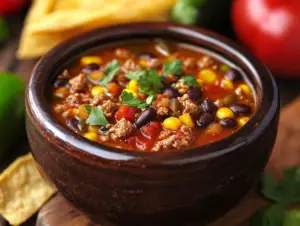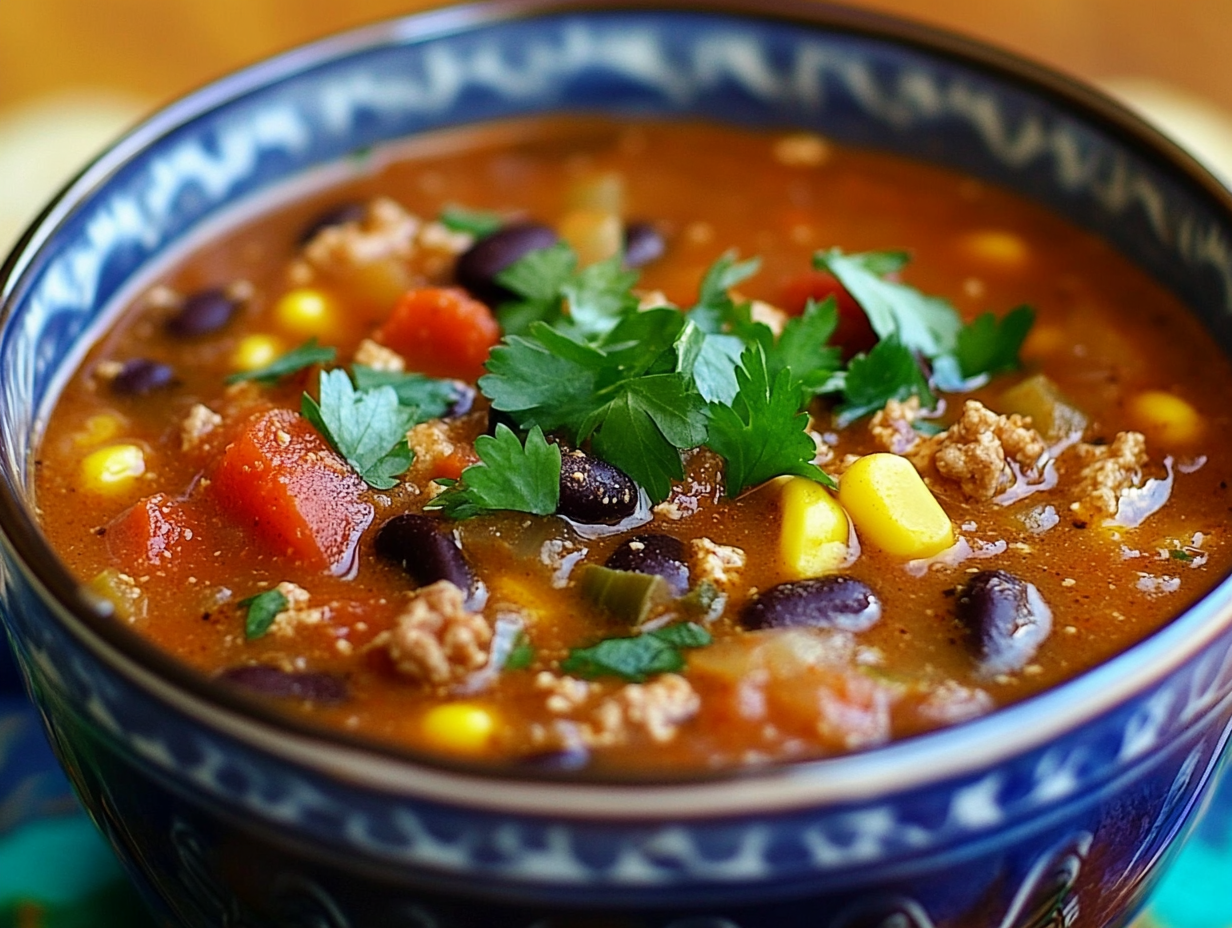Taco soup is a popular dish that fits well into many diets. It’s tasty, hearty, and offers a nutritious option for those looking to stay healthy or lose weight. The calories in taco soup can vary depending on the ingredients, serving size, and how it’s prepared. In this article, we’ll explore the calories in taco soup, how to adjust recipes for health, and answer common questions about its nutrition.
Understanding Taco Soup and Its Nutrition
Taco soup usually includes lean protein like ground beef, turkey, or chicken. It also has beans, corn, tomatoes, and spices like taco seasoning. These ingredients add to the calorie count. Extras like sour cream, cheese, or avocado can raise the total calories.
The average 1-cup serving of taco soup has about 197 calories. However, you can lower that by making ingredient swaps. Learn more about the Calorie Breakdown of Taco Soup to see how different ingredients affect the total nutrition.
How Many Calories Are in a Bowl of Taco Soup?
For a typical recipe, taco soup has around 197 calories per 1-cup serving. This includes lean protein, beans, vegetables, and broth. Calories may range depending on the ingredients used and any toppings added.
Here’s a detailed breakdown for 1 cup (244g) of taco soup:
- Calories: 197
- Fat: 5.32g (24% of total calories)
- Carbs: 20.07g (39% of total calories)
- Fiber: 4.8g (17% of daily value)
- Sugars: 3.14g
- Protein: 18.52g (37% of total calories)
- Sodium: 389mg (17% of daily value)
- Cholesterol: 41mg (14% of daily value)
With a balanced mix of protein, fiber, and carbs, taco soup is a filling meal. For a lighter option, check out this Low-Calorie Taco Soup Recipe.
Factors That Affect the Calories in Taco Soup

Several factors can impact the calorie count in taco soup. Here are the most common ones:
- Protein choice: Using ground turkey or chicken lowers the calorie count. Beef contains more fat and calories.
- Beans and vegetables: Black beans, kidney beans, and corn add fiber and nutrients but also increase the carb count. Using fewer beans or more vegetables can reduce calories.
- Toppings: Toppings like cheese, sour cream, and tortilla chips can quickly increase the calories. For example, 1/4 cup of cheddar cheese adds 100 calories. Try lighter toppings like Greek yogurt or fresh cilantro.
How to Reduce Calories in Taco Soup
If you want a lower-calorie version of taco soup, here are some tips:
- Use leaner proteins: Try ground turkey or chicken instead of beef. You can also use tofu or plant-based proteins for even fewer calories.
- Skip or limit high-calorie toppings: Avoid cheese and sour cream. Instead, use Greek yogurt or cilantro for added flavor without extra calories.
- Add more vegetables: Vegetables like zucchini, bell peppers, and spinach add nutrients and reduce calorie density.
- Use low-sodium broth: Many store-bought broths contain extra calories and sodium. Make your own or choose a low-sodium version to keep it light.
Explore more Tips for Cutting Calories in Soups to make healthier meals.
Taco Soup Recipe Variations and Calories
Taco soup is a versatile dish that can be easily modified to suit different dietary preferences and calorie goals. Below are some popular variations of taco soup and how the calorie count differs based on ingredients:
1. Classic Beef Taco Soup
A traditional beef taco soup uses ground beef as the primary protein source. It is hearty and flavorful but tends to be higher in calories due to the fat content in the beef.
- Main Ingredients: Ground beef, black beans, corn, tomatoes, taco seasoning
- Calorie Range: 250-300 calories per 1-cup serving
- Modifications to Lower Calories:
- Use lean ground beef (93% lean or higher) to reduce the fat content.
- Replace sour cream and cheese with lighter alternatives such as Greek yogurt or skip them altogether.
2. Ground Turkey Taco Soup
Using ground turkey instead of beef is a great way to lower the calorie count while maintaining flavor. Turkey is leaner, making this version a healthier option.
- Main Ingredients: Ground turkey, kidney beans, diced tomatoes, corn, taco seasoning
- Calorie Range: 180-200 calories per 1-cup serving
- Modifications to Lower Calories:
- Choose extra-lean ground turkey (99% fat-free) for even fewer calories.
- Load up on low-calorie vegetables like zucchini and bell peppers for added volume without the extra calories.
3. Vegetarian Taco Soup
For a plant-based or vegetarian option, omit the meat and replace it with more beans or plant-based protein alternatives like tofu. This version is rich in fiber and perfect for those following a vegetarian or vegan diet.
- Main Ingredients: Black beans, pinto beans, corn, tomatoes, vegetable broth, taco seasoning
- Calorie Range: 150-200 calories per 1-cup serving
- Modifications to Lower Calories:
- Use low-sodium vegetable broth to keep the dish heart-healthy.
- Reduce the amount of beans slightly if you’re looking to cut down on carbs.
4. Chicken Taco Soup
Chicken taco soup is a lighter variation that uses lean chicken breast or thighs. It’s lower in fat than beef but still packed with protein, making it ideal for a high-protein, low-calorie meal.
- Main Ingredients: Shredded chicken breast, black beans, corn, diced tomatoes, taco seasoning
- Calorie Range: 170-200 calories per 1-cup serving
- Modifications to Lower Calories:
- Use only chicken breast (no skin) to keep the calories and fat content low.
- Add extra vegetables like spinach or cauliflower for more nutrients without many calories.
5. Low-Carb or Keto Taco Soup
For those following a low-carb or keto diet, this version of taco soup skips the beans and corn, which are higher in carbohydrates, and focuses on protein and healthy fats.
- Main Ingredients: Ground beef or turkey, cream cheese, broth, cheddar cheese, taco seasoning
- Calorie Range: 300-350 calories per 1-cup serving
- Modifications to Lower Calories:
- Use leaner cuts of meat to reduce the fat content.
- Substitute heavy cream with unsweetened almond milk to cut back on calories and fat.
6. Crockpot Taco Soup
Cooking taco soup in a crockpot or slow cooker enhances the flavors and makes it easy to prepare in large batches. The calorie count will depend on the specific ingredients you use, but the slow cooking method itself doesn’t impact the calories.
- Main Ingredients: Ground turkey or beef, beans, corn, tomatoes, broth, taco seasoning
- Calorie Range: Similar to other variations (180-300 calories per serving)
- Modifications to Lower Calories:
- Add extra broth and vegetables to bulk up the soup without significantly increasing the calorie count.
- Skip cheese and chips and use fresh herbs for garnish instead.
7. Spicy Taco Soup
For those who love a bit of heat, spicy taco soup includes extra spices like jalapeños, cayenne pepper, or chipotle peppers in adobo sauce. The added spice doesn’t contribute many calories, making it a great way to boost flavor without adding extra energy.
- Main Ingredients: Ground turkey or chicken, jalapeños, black beans, corn, taco seasoning, hot sauce
- Calorie Range: 180-220 calories per serving
- Modifications to Lower Calories:
- Use low-sodium broth and lean protein to keep it healthy.
- Skip any heavy toppings that could add unnecessary calories.
How Toppings Affect Calorie Count

The type and amount of toppings you use can drastically change the calorie count of your taco soup. Here are common toppings and their approximate calorie contributions:
- Shredded Cheese (1/4 cup): Adds 100 calories
- Sour Cream (2 tablespoons): Adds 60 calories
- Tortilla Chips (10 chips): Adds 140 calories
- Avocado (1/4 medium avocado): Adds 60-70 calories
To keep the calorie count low, opt for lighter toppings such as:
- Fresh cilantro: Almost no calories, adds fresh flavor
- Fat-free Greek yogurt: A low-calorie, high-protein alternative to sour cream
- Lime wedges: Adds zest and flavor without adding any calories
Taco soup is a versatile dish that can be adjusted to fit various dietary needs while keeping the calorie count in check. Whether you prefer beef, chicken, or vegetarian, you can find a version that works for you. By focusing on lean proteins, adding more vegetables, and limiting high-calorie toppings, you can enjoy a healthy and filling meal without overloading on calories.
Health Benefits of Taco Soup
Taco soup is not only delicious but also packed with various nutrients that contribute to overall health. Here are the key health benefits of enjoying taco soup:
- High in Protein: Taco soup is typically made with lean meats like ground turkey, chicken, or even beans for a vegetarian option. These ingredients provide a significant amount of protein, which is essential for maintaining muscle mass, supporting metabolism, and promoting satiety. A typical serving of taco soup offers around 18 grams of protein, keeping you full and energized.
- Rich in Fiber: Ingredients like beans (black beans, kidney beans, or pinto beans) and vegetables such as corn and tomatoes add a healthy dose of dietary fiber. Fiber is crucial for digestion, regulating blood sugar levels, and promoting heart health. High-fiber meals can also help with weight management by keeping you feeling full for longer.
- Low in Calories (When Made Right): A standard 1-cup serving of taco soup contains roughly 197 calories, making it a low-calorie meal option that still feels hearty and satisfying. By using lean proteins, skipping high-calorie toppings, and adding more vegetables, you can enjoy a nutrient-dense meal without consuming excessive calories.
Packed with Vitamins and Minerals: The ingredients in taco soup provide an array of essential vitamins and minerals. For instance:
- Tomatoes are rich in vitamin C and potassium, supporting immune function and heart health.
- Beans and corn provide iron and magnesium, which are important for oxygen transport and muscle function.
- Chili peppers or jalapeños used in seasoning offer a good amount of vitamin A and may boost metabolism.
- Supports Heart Health: The combination of lean proteins, fiber-rich beans, and antioxidant-packed vegetables contributes to a heart-healthy meal. Taco soup can be made with low-sodium broth to reduce the risk of high blood pressure, while its balance of healthy fats, proteins, and fiber supports cardiovascular health.
- Easy to Adapt to Different Diets: Taco soup can be modified to suit various dietary needs. It can be made gluten-free, dairy-free, vegetarian, or low-carb with a few simple ingredient swaps. For example, those following a low-carb or keto diet can replace beans with more vegetables or add extra meat for more protein.
- Boosts Immunity: Thanks to ingredients like tomatoes, garlic, and onions, taco soup contains antioxidants and immune-boosting nutrients. Vitamin C from tomatoes helps strengthen the immune system, while garlic has antibacterial and antiviral properties.
In summary, taco soup offers a wide range of health benefits. Its high protein and fiber content support weight management and digestion, while its vitamins and minerals promote overall wellness. With a few modifications, you can make it even more suitable for your specific health needs.
FAQs About Taco Soup and Calories
How many calories are in taco soup with beef?
A bowl of taco soup made with ground beef contains 250-300 calories, depending on the serving size and toppings.
How do toppings like cheese and sour cream affect the calorie count?
Toppings can add a lot of extra calories. For instance, sour cream adds about 60 calories per tablespoon, while cheese adds 100 calories per 1/4 cup.
Can I lower the calories in taco soup without losing flavor?
Yes! By using lean meats and more vegetables, you can keep it flavorful but light. Skipping heavy toppings like cheese and sour cream will also help.
What’s the best protein for low-calorie taco soup?
Ground turkey or chicken is best for lower-calorie options, but beans or tofu work well for vegetarian versions.
Is homemade taco soup lower in calories than canned?
Yes, homemade taco soup typically has fewer calories because you control the ingredients. Canned versions often have more fats and sodium, which can increase calories.
Taco Soup Meal Prep Tips
Taco soup is an excellent dish for meal prepping due to its versatility and ease of storage. Here are some tips to help you prepare and store taco soup efficiently for later use:
- Portion Control: Divide the taco soup into individual servings (about 1 cup each) and store them in airtight containers. This helps with portion control and makes it easier to grab a quick meal throughout the week. Pre-portioning also helps you avoid overeating.
- Freeze for Later: Taco soup freezes well, making it perfect for long-term meal prep. After cooking, allow the soup to cool completely. Then, transfer it to freezer-safe containers or resealable bags. Freeze for up to 3 months. To save space, you can freeze the soup flat in ziplock bags and stack them.
- Reheating Instructions: To reheat frozen taco soup, thaw it in the refrigerator overnight. When ready to eat, reheat on the stovetop over medium heat or in the microwave. If the soup has thickened while stored, you can add a splash of water or broth to adjust the consistency.
- Add Toppings Later: To prevent toppings from getting soggy, store them separately and add them when you’re ready to eat. Common toppings like cheese, sour cream, avocado, or tortilla chips are best added fresh just before serving.
- Double the Recipe: When prepping meals for the week or month, consider doubling the recipe. This way, you can freeze half for future use and have fresh portions for the week.
- Label and Date: Always label your containers with the date so you can keep track of how long the soup has been stored. This ensures you use the older portions first and prevents food waste.
Serving Suggestions
Taco soup is a hearty dish that pairs well with various healthy sides. Here are some serving suggestions to complete your meal:
- Side Salad: A light green salad with a simple vinaigrette complements the rich flavors of the soup without adding too many extra calories. Try adding avocado slices or a sprinkle of seeds for a nutrient boost.
- Whole-Wheat Tortillas: Serve warm whole-wheat tortillas alongside your soup. They are perfect for dipping or using as a wrap to enjoy the soup’s filling ingredients.
- Cauliflower Rice: For a low-carb alternative to traditional rice, serve cauliflower rice on the side. It adds texture and fills you up without adding significant calories.
- Grilled Vegetables: Lightly grilled vegetables like zucchini, bell peppers, or asparagus pair nicely with the flavors of taco soup. This adds more fiber and nutrients to your meal.
- Tortilla Chips: Baked tortilla chips are a great crunchy addition. Just be mindful of portion sizes as they can add extra calories. Use them to scoop up the soup or sprinkle a few crumbled chips on top.
- Avocado Slices: Add a few slices of avocado on top of the soup for a creamy texture and healthy fats. Just keep in mind that avocado is calorie-dense, so portion control is key.

Conclusion: Enjoy Taco Soup in a Healthy Way
Taco soup is a versatile, nutritious meal with an average of 197 calories per serving. By using lean proteins, limiting high-calorie toppings, and adding extra vegetables, you can enjoy a delicious bowl while staying on track with your health goals.
Whether you’re prepping meals for the week or need a quick dinner, taco soup is easy to make and can be tailored to suit your dietary needs. Try out different variations and enjoy this healthy, comforting dish!

